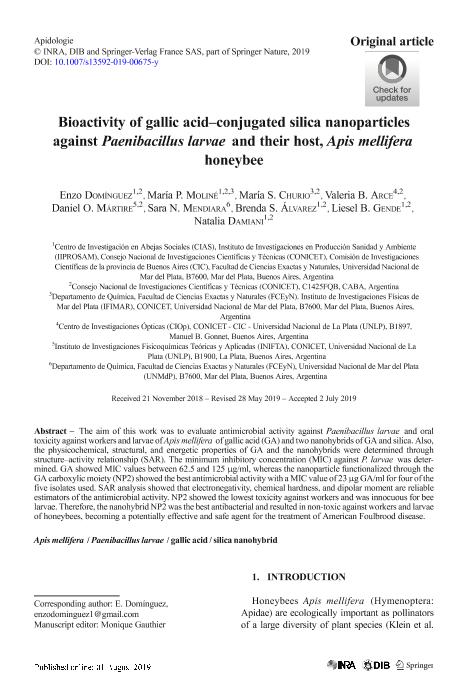Artículo
Bioactivity of gallic acid–conjugated silica nanoparticles against Paenibacillus larvae and their host, Apis mellifera honeybee
Dominguez, Enzo ; Moliné, Maria de la Paz
; Moliné, Maria de la Paz ; Churio, Maria Sandra
; Churio, Maria Sandra ; Arce, Valeria Beatriz; Martire, Daniel Osvaldo; Mendiara, Sara Noemí; Alvarez, Brenda Soledad
; Arce, Valeria Beatriz; Martire, Daniel Osvaldo; Mendiara, Sara Noemí; Alvarez, Brenda Soledad ; Gende, Liesel Brenda
; Gende, Liesel Brenda ; Damiani, Natalia
; Damiani, Natalia
 ; Moliné, Maria de la Paz
; Moliné, Maria de la Paz ; Churio, Maria Sandra
; Churio, Maria Sandra ; Arce, Valeria Beatriz; Martire, Daniel Osvaldo; Mendiara, Sara Noemí; Alvarez, Brenda Soledad
; Arce, Valeria Beatriz; Martire, Daniel Osvaldo; Mendiara, Sara Noemí; Alvarez, Brenda Soledad ; Gende, Liesel Brenda
; Gende, Liesel Brenda ; Damiani, Natalia
; Damiani, Natalia
Fecha de publicación:
08/2019
Editorial:
EDP Sciences
Revista:
Apidologie
ISSN:
0044-8435
Idioma:
Inglés
Tipo de recurso:
Artículo publicado
Clasificación temática:
Resumen
The aim of this work was to evaluate antimicrobial activity against Paenibacillus larvae and oral toxicity against workers and larvae of Apis mellifera of gallic acid (GA) and two nanohybrids of GA and silica. Also, the physicochemical, structural, and energetic properties of GA and the nanohybrids were determined through structure–activity relationship (SAR). The minimum inhibitory concentration (MIC) against P. larvae was determined. GA showed MIC values between 62.5 and 125 μg/ml, whereas the nanoparticle functionalized through the GA carboxylic moiety (NP2) showed the best antimicrobial activity with a MIC value of 23 μg GA/ml for four of the five isolates used. SAR analysis showed that electronegativity, chemical hardness, and dipolar moment are reliable estimators of the antimicrobial activity. NP2 showed the lowest toxicity against workers and was innocuous for bee larvae. Therefore, the nanohybrid NP2 was the best antibacterial and resulted in non-toxic against workers and larvae of honeybees, becoming a potentially effective and safe agent for the treatment of American Foulbrood disease.
Palabras clave:
APIS MELLIFERA
,
GALLIC ACID
,
PAENIBACILLUS LARVAE
,
SILICA NANOHYBRID
Archivos asociados
Licencia
Identificadores
Colecciones
Articulos (IIPROSAM)
Articulos de INSTITUTO DE INVESTIGACIONES EN PRODUCCION, SANIDAD Y AMBIENTE
Articulos de INSTITUTO DE INVESTIGACIONES EN PRODUCCION, SANIDAD Y AMBIENTE
Articulos(CCT - MAR DEL PLATA)
Articulos de CTRO.CIENTIFICO TECNOL.CONICET - MAR DEL PLATA
Articulos de CTRO.CIENTIFICO TECNOL.CONICET - MAR DEL PLATA
Articulos(CIOP)
Articulos de CENTRO DE INVEST.OPTICAS (I)
Articulos de CENTRO DE INVEST.OPTICAS (I)
Articulos(IFIMAR)
Articulos de INST.DE INVESTIGACIONES FISICAS DE MAR DEL PLATA
Articulos de INST.DE INVESTIGACIONES FISICAS DE MAR DEL PLATA
Articulos(INIFTA)
Articulos de INST.DE INV.FISICOQUIMICAS TEORICAS Y APLIC.
Articulos de INST.DE INV.FISICOQUIMICAS TEORICAS Y APLIC.
Citación
Dominguez, Enzo; Moliné, Maria de la Paz; Churio, Maria Sandra; Arce, Valeria Beatriz; Martire, Daniel Osvaldo; et al.; Bioactivity of gallic acid–conjugated silica nanoparticles against Paenibacillus larvae and their host, Apis mellifera honeybee; EDP Sciences; Apidologie; 50; 5; 8-2019; 616-631
Compartir
Altmétricas



